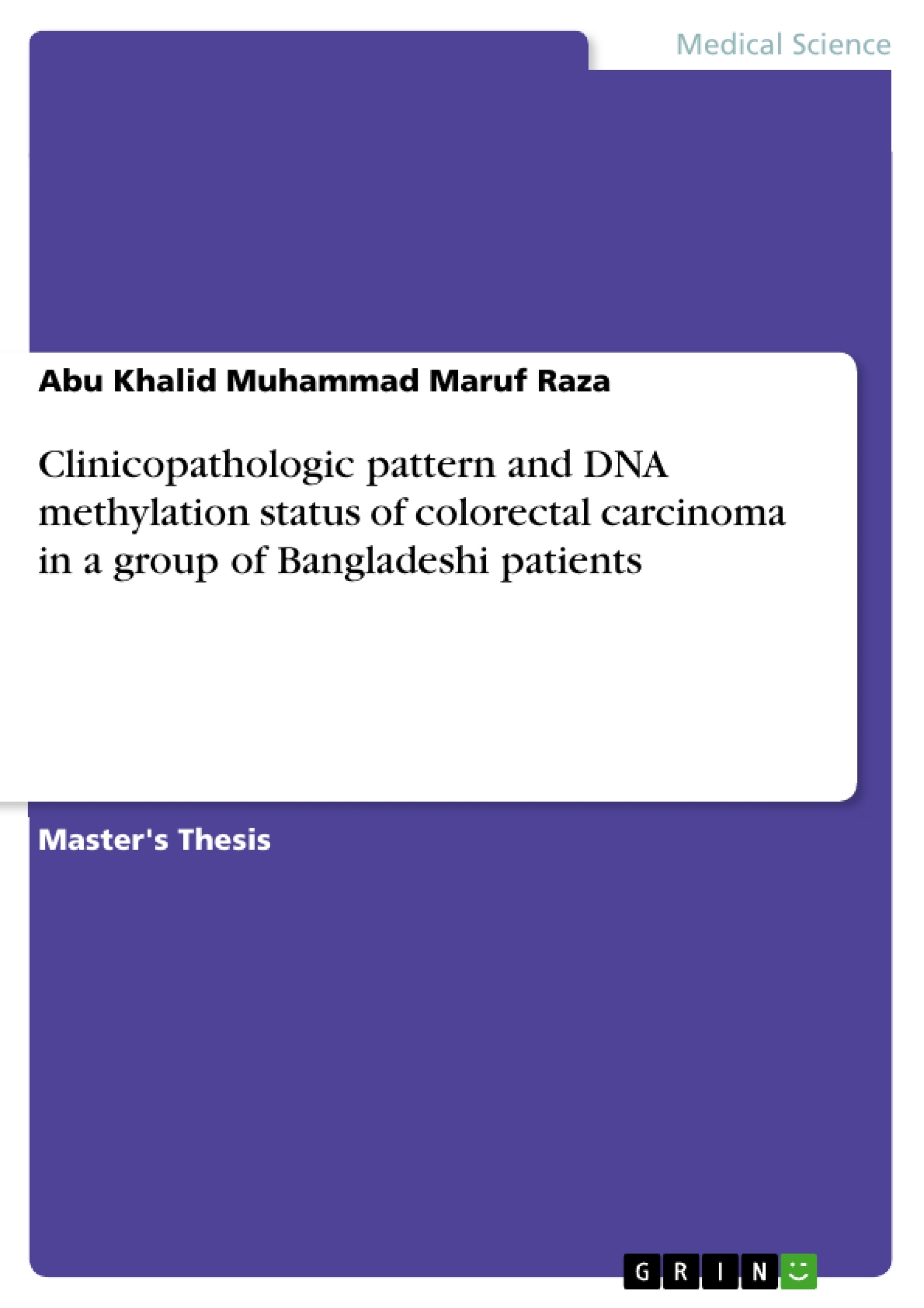Colorectal cancer (CRC) is the third most common cancer in the world and the second leading cause of cancer related deaths in the United States. Globally, the incidence of CRC varies widely with higher incidence rates in North America, Australia and Northern and Western Europe (Aljebreen, 2007). The lifetime risk of developing CRC is about 6% or one in 18. Over 95% of these CRC is adenocarcinoma (Kim et al, 2010). CRC is relatively uncommon in Indian sub continent. In India the incidence of colorectal cancer was found to be 4.2 and 3.2 per hundred thousand for male and female population respectively (Afroza et al, 2007).
The incidence of colorectal cancer in Bangladesh is not exactly known, it appears to be common and occur in younger age group with slight male preponderence. Average age at diagnosis is 10 years less than the developed countries. Rectal bleeding is the most common symptoms and majority of the carcinoma were in the rectum (Hossain, 2007). The peak incidence of colorectal carcinoma is in between the age of 60 and 69 years.Fewer than 20% occur before the age of 50 years. Males are affected slightly more than females (Turner, 2010). Colorectal carcinoma are rare before the age of 40 without genetic predisposition or without predisposing factors (Hamilton, 2000). Early detection of colonic cancers is a challenging task as because clinical symptoms develop slowly. Per rectal bleeding is common. Many patients experience change in bowel habit (Yawe et al, 2007). Screening tests like digital rectal examination, simple laboratoryinvestigations like estimation of CEA, estimation of haemoglobin, faecal occult blood test,and visualization of the gut mucosa by sigmoidoscopy and colonoscopy examination may be a help in the diagnosis (Aljebreen, 2007). Colorectal cancer is a multifactorial disease process. Etiology contributing from environmental factors including diatery factors, obesity, alcohol intake, smoking, life style and genetic and epigenetic abnormalities. The molecular events that leads to CRC is heterogenous and includes genetic and epigenetic abnormalities. Genetic events in colorectal cancer is genetic alteration of the APC gene, mutations in the KRAS and P53 gene and abnormalities in the DNA mismatched repair genes (Turner, 2010). Epigenetic changes, which is the heritable changes in gene function that are not due to changes in the DNA sequence is an important pathway in the mechanism of tumerogenesis in colorectal cancer. [...]
Inhaltsverzeichnis (Table of Contents)
- INTRODUCTION
- REVIEW OF LITERATURE
- Anatomical consideration
- Physiology
- Tumors of the colon and rectum
- MATERIALS AND METHODS
- OBSERVATIONS AND RESULTS
- DISCUSSION
- SUMMARY AND CONCLUSION
- BIBLIOGRAPHY
- APPENDICES
Zielsetzung und Themenschwerpunkte (Objectives and Key Themes)
This study aims to investigate the clinicopathologic pattern and DNA methylation status of colorectal carcinoma (CRC) in a group of Bangladeshi patients. The study aims to analyze the prevalence and characteristics of CRC in this population and explore the role of DNA methylation in the development and progression of the disease.
- Clinicopathologic characteristics of colorectal cancer in Bangladeshi patients
- Analysis of DNA methylation status in CRC cases
- Correlation of methylation status with clinical and pathological features
- Potential implications of methylation findings for diagnosis and treatment
- Comparison of findings with previous studies in other populations
Zusammenfassung der Kapitel (Chapter Summaries)
- Introduction: Provides an overview of colorectal cancer (CRC), including its global prevalence, risk factors, and challenges in early detection. It highlights the limited data on CRC in Bangladesh and emphasizes the need for further research in this context.
- Review of Literature: Discusses the anatomical and physiological aspects of the colon and rectum, emphasizing the specific features of CRC, its pathogenesis, and existing knowledge on DNA methylation in cancer development.
- Materials and Methods: Outlines the methods employed in the study, including the patient selection criteria, collection of clinical and pathological data, DNA extraction and methylation analysis techniques.
- Observations and Results: Presents the study findings regarding the clinicopathologic characteristics of CRC cases, including demographics, tumor location, histopathology, and DNA methylation patterns.
- Discussion: Interprets the results in relation to existing literature, highlighting the similarities and differences observed in the Bangladeshi population. It discusses the potential implications of the study findings for clinical practice and future research directions.
Schlüsselwörter (Keywords)
This study focuses on the clinical and molecular aspects of colorectal cancer (CRC) in Bangladesh. It explores the clinicopathologic pattern, DNA methylation status, and potential associations with tumor characteristics. The study utilizes various methodologies including histopathological analysis, immunohistochemistry, and DNA methylation profiling.
- Citar trabajo
- Dr. Abu Khalid Muhammad Maruf Raza (Autor), 2010, Clinicopathologic pattern and DNA methylation status of colorectal carcinoma in a group of Bangladeshi patients, Múnich, GRIN Verlag, https://www.grin.com/document/346420



